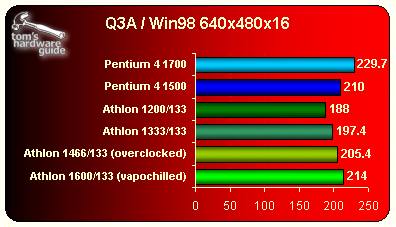Intel Pentium 4 1.7 GHz: More Power For Less Money
Benchmarks
Sysmark2001
BAPCo just released its new Sysmark2001, which is the successor of the well-known Sysmark2000. This evaluation software is meant to test office application performance as well as Internet content creation speed on PC systems. While Sysmark2000 was running its test applications sequentially, Sysmark2001 is now using the more realistic approach of parallel system workloads. The benchmark runs with several applications open at the same time and the simulated user switching between them, just as we do on our systems as well. BAPCo wanted to improve the real world value of its popular Sysmark evaluation software and it seems as if they did a pretty good job.
Many people expected Sysmark2001 to favorite Pentium 4, because Intel is after all an important member of BAPCo and certainly disliked the fact that Pentium 4 was so badly outscored by Athlon in the previous Sysmark2000 version. Surprisingly enough, Athlon is still well ahead of Pentium 4 in Sysmark2001 as well. Intel's brand new Pentium 4 1.7 GHz is not even able to reach the Sysmark2001-scores of Athlon 1200.
Once we look at the details, we can see that Athlon easily outruns Pentium 4 in terms of office productivity. The Pentium 4 scores are rather sad in fact.
In terms of Internet content creation however, Pentium 4 is able to catch up and even overtake Athlon. Pentium 4 1.7 GHz is a tiny bit faster than Athlon 1333.
Sysmark2000
As Sysmark2001 is brand new, we still decided to include Sysmark2000 runs as well.
We already know this picture. Pentium 4 is not able to reach Athlon-scores. What surprises however, is the fact that in the overall score Pentium 4 lags just as much behind Athlon in the older version of Sysmark as it does in the new one. We learn that the more realistic shared-workload model of the new benchmark doesn't seem to change the outcome one bit. Intel always claimed that Pentium 4 would be particularly good at those task-switching workloads, partly because of RDRAM-memory. We can now see that this doesn't seem to be the case.
Get Tom's Hardware's best news and in-depth reviews, straight to your inbox.
3D Games
Quake 3 Arena
We already know that for some surprising reasons Quake 3 Arena is the only old 3D-game that shows Pentium 4 in a particularly good light. This might be based on the fact that Intel enjoys a very close relationship with Id.
At the low resolution of 640x480x16, which makes sure that the graphics card doesn't become the bottleneck, Pentium 4 is clearly leading the pack. Even Pentium 4 1.5 GHz is able to leave the fastest Athlon processor behind.
Once the screen resolution and color depth has reached real-world levels, the 3D-card is limiting the frame rate scores. All processors score alike.
NVIDIA's NV15-demo is more of a processor test than the Demo001 from above. Due to the higher polygon count and the amount of lighting effects the processor has to do a lot more work. In this test Pentium 4 1.7 is beating Athlon 1333 as well, but the margin has shrunk quite a bit.
At real-world resolution Pentium 4 1.7 GHz is still able to leave the 'unoverclocked' Athlon fraction behind, although the differences aren't very big anymore.







